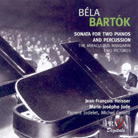March 2004
The Miraculous Mandarin written between 1918 and 1925, was the last of Bartók’s compositions for the stage, coming after Bluebeard’s Castle and The Wooden Prince. A savage, yet lyrical piece, it shows the composer perfecting his Hungarian nationalistic style. The work is replete with motor rhythms we have come to associate with this composer, but also graceful, lyrical melodies that harken back to Hungarian folk-music roots. The version for two pianos was written simultaneously with the score for large orchestra. The cover of this CD is a photo of the composer and his wife playing together at a concert in Budapest, so one presumes that Bartók wrote the duo-piano version so he could perform it himself. This version reveals more of the structure and lyricism of the work than the orchestral arrangement does. The Sonata for Two Pianos and Percussion premiered in 1938. The composer was very specific as to the arrangement of the instruments on stage. The percussion instruments sometimes color the piano part, sometimes accent it, and sometimes the timpani and xylophone take on a melodic role. This music foreshadows the dynamic composer who would write the famous Concerto for Orchestra in 1943. The performers on this disc are superb. Both pianists bring sure technique and an innate sense of rhythm and lyricism to their playing. The percussionists do exactly what Bartók wanted, as described in the previous paragraph. This recording, in a format that allows six discrete channels, could have easily been a disaster. The pianos could have been left and right with percussion coming from all over the place. Producer Pierre E. Barbier has wisely chosen not to be tempted, but to put all the instruments up front, as they would be in concert. The soundstage is deeper rather than wide, and the ambiance is very tasteful. The rear channels never call attention to themselves yet provide a sense of space that is missing in the SACD two-channel version. I find the sound quite natural and satisfying and note that the high resolution of the DSD recording allows the nuances of scoring in the Sonata to come through with absolute clarity. This an off-the-beaten-track disc that will become a regular listen. GO BACK TO: |
 Béla Bartók - Sonata
for Two Pianos and Percussion; The Miraculous Mandarin; Two Pictures
Béla Bartók - Sonata
for Two Pianos and Percussion; The Miraculous Mandarin; Two Pictures The three works on this enjoyable disc span composer Béla
Bartók’s lifetime. The Two Pictures, originally composed for orchestra, was
written in 1910 and shows its author under the influence of Debussy. Bartók, as always in
his music, imbued his composition with folk-music elements from his native Hungary. The
two piano transcription was created in 1976 by pianist-conductor Zoltán Kocsis. If the
two-piano version loses some of the sheer voluptuousness of the original, it more than
makes up for that in a shimmering quality that is still highly impressionistic.
The three works on this enjoyable disc span composer Béla
Bartók’s lifetime. The Two Pictures, originally composed for orchestra, was
written in 1910 and shows its author under the influence of Debussy. Bartók, as always in
his music, imbued his composition with folk-music elements from his native Hungary. The
two piano transcription was created in 1976 by pianist-conductor Zoltán Kocsis. If the
two-piano version loses some of the sheer voluptuousness of the original, it more than
makes up for that in a shimmering quality that is still highly impressionistic.